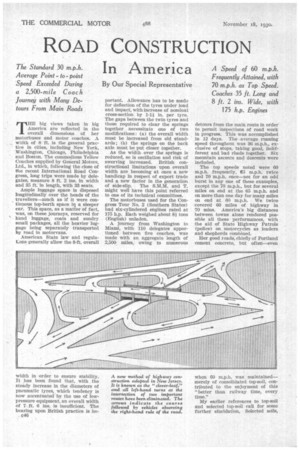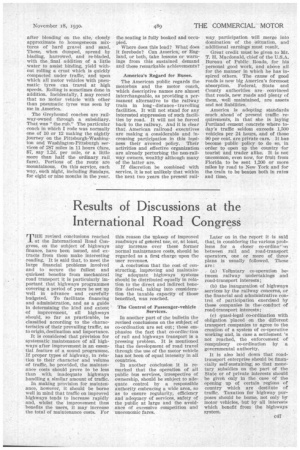ROAD CONSTRUCTION
Page 68

Page 69

If you've noticed an error in this article please click here to report it so we can fix it.
In America
By Our Special Representative
The Standard 30 m.p.h. Average Point to point Speed Exceeded During a 2,500-mile Coach Journey with Many Detours From Main Roads A Speed of 60 m.p.h. Frequently Attained, with 70 m.p.h. as Top Speed. Coaches 35 ft. Long and 8 ft. 2 ins. Wide, with 175 h.p. Engines • THE big views taken in big
America are reflected in the overall dimensions of her motorbuses and motor coaches. A width of 8 ft. is the general practice in cities, including New 'York, Washington, Chicago, Philadelphia and Boston. The commodious Yellow Coaches supplied by General Motors, Ltd., in which, following the close of the recent International Road Congress, long trips were made by delegates, measure 8 ft. 2 ins, in width and 35 ft. In length, with 33 seats.
Ample luggage space is disposed longitudinally over the heads of the travellers—much as if it were continuous top-berth space ir a sleeper car. This space, as a matter of fact, was, on these journeys, reserved for
. band luggage, coats and sundry small packages, all the heavier luggage being separately transported by road in motors-mils.
American State law and regulations generally allow the 8-ft. overall
width in order to ensure stability. It has been found that, with the steady increase in the diameters of pneumatic tyres,. which tendency is now accentuated by the use of lowpressure equipment, an overall width of 7 ft. 6 ins. is insufficient. The bearing upon British practice is itn c46 portant. Allowance has to be made for deflection of the tyres under load and impact, with increase of nominal cross-section by 1-11 in. per tyre. The gaps between the twin tyres and those required to clear the springs together necessitate one of two modifications : (a) the overall width must be increased from old standards ; (b) the springs on the back axle must be put closer together.
As the width over the springs is reduced, so is oscillation and risk of swerving increased. British constructional limitations upon overall width are becoming at once a new handicap in respect of export trade and a new factor in the generation of side-slip. The S.M.M. and T. might well have this point referred to one of its technical committees.
The motorbuses used for the Congress Tour No. 2 (Southern States) had six-cylindered engines rated at 175 h.p. Each weighed about 81 tons (English) unladen.
A journey from Washington to Miami, with 110 delegates apportioned between five coaches, was made with an aggregate length of 2,500 miles, owing to numerous detours from the main route in order to permit inspections of road work in progress. This was accomplished in 12 days. The -average running speed throughout was 36 m.p.h., exclusive of stops, taking good, indifferent and bad roads together. Six mountain ascents and descents were included.
The top speeds noted were 60 m.p.h. frequently, €5 m.p.h. twice and 70 m.p.h. once—not for an odd burst in any one of these examples, except the 70 m.p.h., but for several miles on end at the 65 m.p.h. and on more than one day for many miles on end at 60 m.p.h. We twice covered 60 miles of highway in 70 mins. America's big distances between towns alone rendered possible all these performances, with the aid ef State Highway Patrols (police) on motorcycles as leaders and shepherds combined.
Her good roads, chiefly of Portland cement concrete, but often—even when 60 m.p.h. was maintained— merely of consolidated top-soil, contributed to the enjoyment of this "better than railway time, every time."
My earlier references to top-soil and selected top-soil call for some further elucidation. Selected soils, after blending on the site, closely approximate to homogeneous mixtures of hard gravel and sand. These, when dumped, spread by blading, harrowed, and re-bladed, with the final addition of a 'little water to assist binding, yield without rolling a crust 'Which is quickly compacted under traffic, and upon which all motor vehicles With pneumatic tyrea can travel at high speeds. Rolling is sometimes done in addition. Incidentally, I may record that no motor vehicle with other than pneumatic tyres was seen by me in America.
The Greyhound coaches are railway-owned through a subsidiary. That was "the rub." The particular coach in which I rode was normally one of 10 or 12 making the nightly journey on the Pittsburgh-Washington and Washington-Pittsburgh services of 287 miles in 11 hours (fare, $7, say 1.2d. per mile, or a little more than half the ordinary rail fare). Portions of the route are mountainous. On this service, each way, each night, including Sundays, for eight or nine months in the year, the seating is fully booked and occupied.
Where does this lead? What does it forebode? Can America, or England, or both, take lessons or warnings from this sustained demand and these remarkable achievements?
America's Regard for Ruses.
The American public regards the motorbus and the motor coach, which descriptive names are almost interchangeable, as providing a permanent alternative to the railway train in longdistancetravelling facilities. It will not stand for any interested suppression of such facilities by road. It will not be forced back to the railway. And it is clear that. American railroad executives are making a considerable and increasing participation in this business their avowed policy. Their activities and effective organization are already perturbing the non-railway owners, wealthy although many of the latter are.
If discretion be combined with service, it is not unlikely that within the next two years the present rail
way participation will merge into domination of the situation, and additional earnings must result.
Great credit must be given to Mr. T. H. Macdonald, chief of the U.S.A. Bureau of Public Roads, for his personal good work, and above all for the manner in which he has inspired others. The cause of good roads is now big America's foremost absorption. Federal, State and County authorities are• convinced that roads, new roads and plenty of them, well maintained, are assets and not liabilities.
America is adopting standards much ahead of present traffic requirements, in that she is laying Portland cement concrete where today's traffic seldom exceeds 1,500 vehicles per 24 hours, and of those 90 per cent. are private cars. It has become public policy to do so, in order to open up the country for tourist and trader alike. It is not uncommon, even now, for fruit from Florida to be sent 1,200 or more miles by road to New York and for the train to be beaten both in rates and time.












































































































